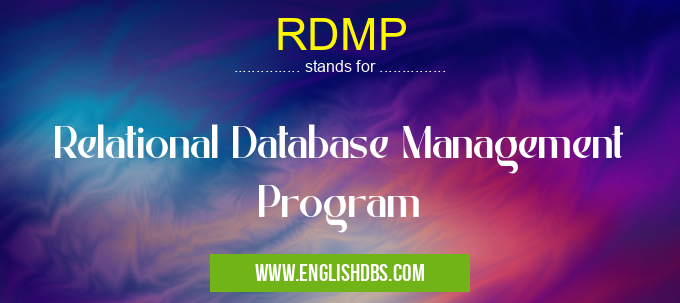What does RDMP mean in MANAGEMENT
RDMP stands for Relational Database Management Program. A relational database management system (RDBMS) is a software program that allows users to create, manage, and access data in a relational database. Relational databases are organized into tables, which are made up of rows and columns. Each row in a table represents a single record, and each column represents a field within that record.

RDMP meaning in Management in Business
RDMP mostly used in an acronym Management in Category Business that means Relational Database Management Program
Shorthand: RDMP,
Full Form: Relational Database Management Program
For more information of "Relational Database Management Program", see the section below.
» Business » Management
How RDMPs Work
RDMPs use a structured query language (SQL) to interact with the database. SQL commands can be used to create and modify tables, insert and delete data, and perform queries on the data. RDMPs also provide a number of features to help users manage their databases, such as transaction logging, data backup and recovery, and user authentication.
Benefits of Using RDMPs
RDMPs offer a number of benefits over other types of database management systems, including:
- Scalability: RDMPs can be scaled to support large databases with millions or even billions of records.
- Reliability: RDMPs are designed to be highly reliable, and they can provide data backup and recovery features to protect against data loss.
- Security: RDMPs provide a number of security features to protect data from unauthorized access.
- Ease of use: RDMPs are relatively easy to use, and they can be used by users with a variety of skill levels.
Conclusion
RDMPs are a powerful tool for managing data. They offer a number of benefits over other types of database management systems, including scalability, reliability, security, and ease of use. RDMPs are used in a wide variety of applications, including customer relationship management (CRM), enterprise resource planning (ERP), and data warehousing.
Essential Questions and Answers on Relational Database Management Program in "BUSINESS»MANAGEMENT"
What is a Relational Database Management Program (RDMP)?
A Relational Database Management Program (RDMP) is a software that allows users to create, manage and manipulate data stored in a relational database. It enables users to organize data into tables, define relationships between tables, and perform various operations such as data entry, retrieval, and updates.
What are the benefits of using a RDMP?
Using a RDMP offers several benefits, including:
- Data Organization: RDMPs help organize data into logical tables, making it easier to store, retrieve, and manage.
- Data Integrity: They ensure data integrity by enforcing data constraints and relationships, reducing the likelihood of data errors.
- Data Security: RDMPs provide data security by controlling access to data and protecting it from unauthorized changes.
- Scalability: They can handle large volumes of data and scale up to meet growing data storage and processing needs.
- Data Analysis: RDMPs come with powerful data analysis capabilities, allowing users to extract insights and make informed decisions.
What are some popular RDMPs?
Some popular RDMPs include:
- MySQL
- PostgreSQL
- Microsoft SQL Server
- Oracle Database
- IBM DB2
How do I choose the right RDMP for my needs?
Selecting the right RDMP depends on several factors, including:
- Data Volume: Consider the volume and complexity of your data when choosing an RDMP.
- Performance Requirements: Determine the speed and efficiency required for your data operations.
- Scalability: Consider the potential growth in your data volume and ensure the RDMP can scale accordingly.
- Cost: Evaluate the cost of the RDMP, including licensing, maintenance, and support.
- Features and Functionality: Assess the features and functionality offered by different RDMPs to meet your specific requirements.
What are the key features of a RDMP?
Key features of a RDMP include:
- Data Modeling: Ability to create and modify data models, define tables, columns, and relationships.
- Data Manipulation: Capabilities to perform operations such as data insertion, deletion, updates, and retrieval.
- Data Security: Mechanisms for controlling access to data, enforcing data constraints, and protecting data from unauthorized changes.
- Query Execution: Ability to execute queries to retrieve, filter, and manipulate data based on specific criteria.
- Transaction Management: Support for transactions to ensure data integrity and consistency during concurrent operations.
- Backup and Recovery: Features for backing up data and restoring it in case of data loss or corruption.
